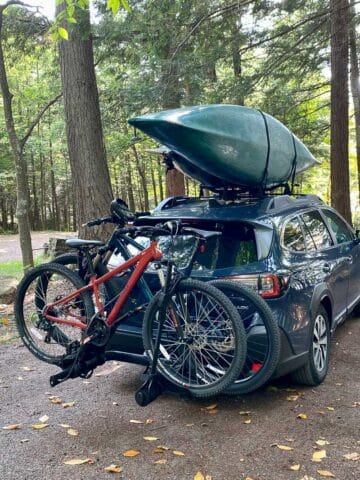Want to start kayaking, but aren’t sure what you’ll need? This is a collection of some of our favorite kayaking gear for beginners.

Maybe you're interested in expanding your options for outdoor fun — I know that's what we've been doing the past couple of years!
Hiking will always be one of our great loves, but sometimes it's fun to enjoy the scenery through a different medium.
That's why we started trying out some beginner's mountain biking gear. And next up on the list? Kayaking!
This year we've included kayaking in our trips to Cranberry Lake in New York, Kincaid Lake in Kentucky, and Kelleys Island in Ohio, and we'll definitely be looking for more opportunities in the future.
So, if you'd like to test out the waters (pun intended), what might you need to shop for? I've got some ideas for you.
All of the observations below apply to canoeing as well.
Should You Buy a Kayak?
The first thing I want to reassure you of is this: Owning a kayak is not required!
Kayaks are expensive. I recommend renting or borrowing a kayak until you're sure you want to invest in one.

There are so many different styles of kayaks and lots of different scenarios to consider. There are ocean-safe kayaks, sit-on-top kayaks, inflatable kayaks, foldable kayaks, and more.
Traditional kayaks require a vehicle that's setup to transport your kayak (such as a roof rack).
If you buy a kayak, or even if you just regularly borrow a friend's kayak, you'll likely also need to invest in a system to attach your kayaks to the roof-rack of your car. We've been extremely happy with this Thule compass kayak rack, which allows us to haul two kayaks at once.

If your vehicle isn't able to transport a traditional kayak, a foldable one (like these oru kayaks) might be a good option.
Since there are so many different factors to consider, renting or borrowing first can help you narrow down what style you'd like.
Kayak aside, here's our favorite kayaking gear for beginners.
Basic Gear
Safety first when you're kayaking! You'll need a personal flotation device. If you're renting, that likely comes with your kayak.
After you've protected yourself, make sure to protect your stuff from an unexpected splash or dunking. These waterproof dry bags are helpful for packing a bottle of water, a lunch and snacks, a beach towel and your car keys/wallet.
And, of course, waterproof phone cases are a great idea.
A pair of water shoes is useful because the rubber soles can give you a good grip on a wet surface. If you decide to get out of the kayak and do some wading or swimming, they'll drain and dry quickly when you're finished.

Cool-Water Kayaking Gear
If the water will be cooler than about 70 degrees F, you may want to take extra precautions to stay warm.
For cool days, I like this neoprene jacket and these neoprene pants. If it's too warm for a neoprene jacket, I like the neoprene pants paired with this NRS hoodie dress.
Neoprene will keep your core warm if it's cold and windy, and will help keep you warm if you should happen to fall in the water.

In chillier seasons, take along a warm jacket to put over your neoprene. I like my North Face Triclimate Jacket because it comes with layers and helps block the wind.
A head covering like a beanie hat will help you conserve warmth.
If the water will be colder than 60 degrees F, you may want to take even more precautions, such as wearing a full dry suit and neoprine booties.
When we went underground kayaking in Red River Gorge, warm socks and gloves were essential! The NRS Hydroskin 0.5 socks and NRS Women's HydroSkin gloves are great options.
As you can see, kayaking gear doesn't need to be elaborate to be useful. A little attention to comfort and safety before you go kayaking will give you the best chance of relaxing and just enjoying the experience!







Leave a Comment: